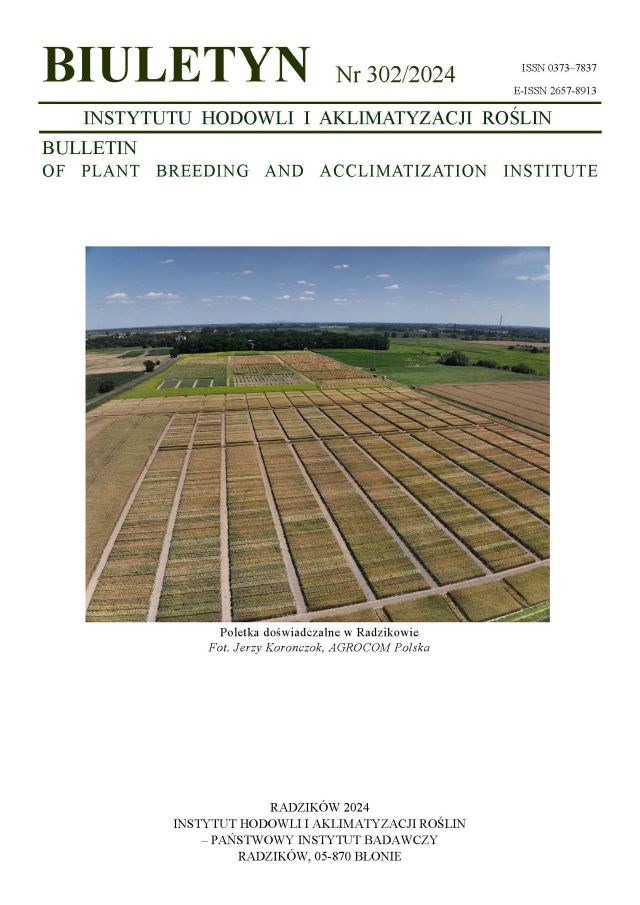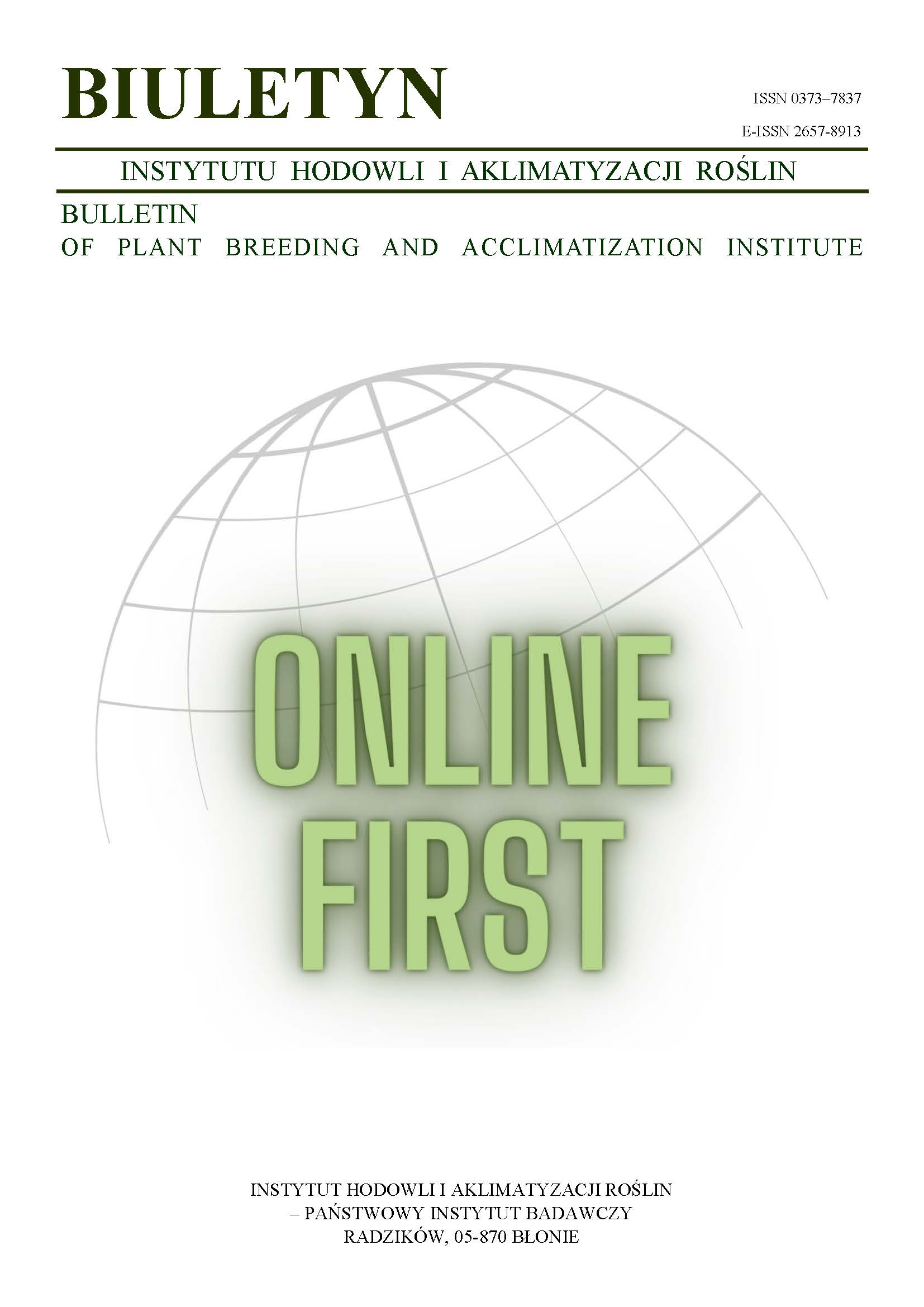Response of potato plants of the cultivar Mila to some adjuvants used in seed crop protection
Janusz Urbanowicz
j.urbanowicz@ihar.edu.plPracownia Ochrony Ziemniaka, Zakład Nasiennictwa i Ochrony Ziemniaka w Boninie, Instytut Hodowli i Aklimatyzacji Roślin w Radzikowie (Poland)
Sławomir Wróbel
Pracownia Nasiennictwa Ziemniaka, Zakład Nasiennictwa i Ochrony Ziemniaka w Boninie, Instytut Hodowli i Aklimatyzacji Roślin w Radzikowie (Poland)
Abstract
Our research goal is to determine whether plant oil-based adjuvants alone could be used for seed potato crop protection against virus infections. In this study the phytotoxicity effect of three adjuvants (Dedal 90 EC, Olejan 85 EC and Superam 10 Al.) on potato plants was tested in the year 2004 in greenhouse experiments. The mineral oil — Sunspray 850 EC was used as a control. In the vegetative period (VI–IX) 10 applications of the mixture of oil with water, at various concentrations (1%, 3% and 5%), were performed in the 7 days intervals. The effect of the adjuvants on phytotoxicity response was evaluated 3 days after every application. Our preliminary data showed that there were no symptoms (including chlorosis and wilting) on potato plants after application of 1% concentrated adjuvants. However, at higher concentrations induction of phytotoxic response occurred and lowered tuber yield by 25%–45% (depending on the adjuvant used).
Keywords:
adjuvants, mineral oil, phytotoxicity effect, plant oil, potatoReferences
Asjes C. J., Blom-Barnhoorn G. J. 1994. Air-borne field spread of tulip breaking virus, lily symptom less virus and lily virus X in lily affected by seasonal incidence of flying aphids and control by sprays of mineral oil, vegetable oil, insecticide and pheromone in the Netherlands. ISHS Acta Horticulturae 377, IIX International Symposium on Virus Diseases of Ornamental Plants, Prague, Czech Republic, October 1994 — www.actahort.org/books/377/377_32.htm.
DOI: https://doi.org/10.17660/ActaHortic.1994.377.32
Google Scholar
Goszczyński W., Tomczyk A., Bednarek A. 2003. Wpływ oleju mineralnego Sunspray 850 EC (Ultra Fine) na wymianę gazową liści róż. Prog. Plant Prot. 43 (2): 648 — 650.
Google Scholar
Kerlan C., Robert Y., Guillery E. 1987. Mise au point sur l’incidence du virus Y0 et méthodes de lutte mises en oeuvre en France pour la production de semences de pomme de terre. Potato Res. 30: 651 — 667.
DOI: https://doi.org/10.1007/BF02367645
Google Scholar
Ko W. H., Wang S. Y., Hsieh T. F., Ann P. J. 2003. Effects of sunflower oil on tomato powdery mildew caused by Oidium neolycopersici. J. Phytopathology 151 (3): 144 — 148.
DOI: https://doi.org/10.1046/j.1439-0434.2003.00698.x
Google Scholar
McKenna C. E. 1999. Evaluation of vegetable oils for armoured scale control in kiwifruit orchards. ISHS Acta Horticulturae 498, IV International Symposium on Kiwifruit, Santiago, Chile, August 1999 — www.actahort.org/books/498/498_45.htm
DOI: https://doi.org/10.17660/ActaHortic.1999.498.45
Google Scholar
Nikolov A. 2000. The efficiency of vegetable oil from Cruciferae on powdery mildew from cucumbers and influence on pollen germination. Bulg. J. Agric. Sci. 6: 609 — 612.
Google Scholar
Northover J., Timmer L. 2002. Control of plant diseases with petroleum – and plant derived oils. In: Beattie G. A. C., Watson D. M., Stevens M. L., Rae D. J., Spooner-Hart R. N., eds. Spray Oils Beyond 2000. Univ. Western Sydney: 512 — 526.
Google Scholar
Praczyk T. 2001. Rozwój badań i zastosowań adiuwantów w Polsce. Prog. Plant. Prot. 41 (1): 110 — 114.
Google Scholar
Turska E. 1984. Limiting of potato tuber infection by non-persistent viruses by plant spraying with mineral oils. Zesz. Probl. Post. Nauk Rol. 310: 99 — 110.
Google Scholar
Turska E., Wróbel S. 1999. Ograniczenie szerzenia się wirusa Y ziemniaka (PVY) przy użyciu oleju Sunspray 11 E. Prog. Plant. Prot. 39 (2): 841 — 844.
Google Scholar
Wojdyła A. T. 2002. Oils activity in the control of rose powdery mildew. Meded Rijksuniv Gent Fak Landbouwkd Toegep Biol Wet. 67 (2): 369 — 376.
Google Scholar
Authors
Janusz Urbanowiczj.urbanowicz@ihar.edu.pl
Pracownia Ochrony Ziemniaka, Zakład Nasiennictwa i Ochrony Ziemniaka w Boninie, Instytut Hodowli i Aklimatyzacji Roślin w Radzikowie Poland
Authors
Sławomir WróbelPracownia Nasiennictwa Ziemniaka, Zakład Nasiennictwa i Ochrony Ziemniaka w Boninie, Instytut Hodowli i Aklimatyzacji Roślin w Radzikowie Poland
Statistics
Abstract views: 23PDF downloads: 10
License
Copyright (c) 2005 Janusz Urbanowicz, Sławomir Wróbel

This work is licensed under a Creative Commons Attribution-ShareAlike 4.0 International License.
Upon submitting the article, the Authors grant the Publisher a non-exclusive and free license to use the article for an indefinite period of time throughout the world in the following fields of use:
- Production and reproduction of copies of the article using a specific technique, including printing and digital technology.
- Placing on the market, lending or renting the original or copies of the article.
- Public performance, exhibition, display, reproduction, broadcasting and re-broadcasting, as well as making the article publicly available in such a way that everyone can access it at a place and time of their choice.
- Including the article in a collective work.
- Uploading an article in electronic form to electronic platforms or otherwise introducing an article in electronic form to the Internet or other network.
- Dissemination of the article in electronic form on the Internet or other network, in collective work as well as independently.
- Making the article available in an electronic version in such a way that everyone can access it at a place and time of their choice, in particular via the Internet.
Authors by sending a request for publication:
- They consent to the publication of the article in the journal,
- They agree to give the publication a DOI (Digital Object Identifier),
- They undertake to comply with the publishing house's code of ethics in accordance with the guidelines of the Committee on Publication Ethics (COPE), (http://ihar.edu.pl/biblioteka_i_wydawnictwa.php),
- They consent to the articles being made available in electronic form under the CC BY-SA 4.0 license, in open access,
- They agree to send article metadata to commercial and non-commercial journal indexing databases.
Most read articles by the same author(s)
- Jerzy Osowski, Janusz Urbanowicz , Silver scab (Helminthosporium solani) – symptoms and control , Bulletin of Plant Breeding and Acclimatization Institute: No. 294 (2021): Regular issue
- Jerzy Osowski, Janusz Urbanowicz, The influence of microstarters B and K on the volume and quality of potato tubers , Bulletin of Plant Breeding and Acclimatization Institute: No. 292 (2020): Special issue
- Józefa Kapsa, Marek Mrówczyński, Tomasz Erlichowski, Hanna Gawińska-Urbanowicz, Konrad Matysek, Jerzy Osowski, Maria Pawińska, Janusz Urbanowicz, Sławomir Wróbel, Potato protection according to the principles of integrated pest management. Part II. Sustainable method of chemical potato protectio , Bulletin of Plant Breeding and Acclimatization Institute: No. 273 (2014): Regular issue
- Józefa Kapsa, Marek Mrówczyński, Tomasz Erlichowski, Hanna Gawińska-Urbanowicz, Konrad Matysek, Jerzy Osowski, Maria Pawińska, Janusz Urbanowicz, Sławomir Wróbel, Potato protection according to the principles of integrated pest management. Part I. Non-chemical methods of protection , Bulletin of Plant Breeding and Acclimatization Institute: No. 273 (2014): Regular issue
- Mariusz Kucharski, Janusz Urbanowicz, Determination of linuron and MCPA residues in soil and potato plants , Bulletin of Plant Breeding and Acclimatization Institute: No. 248 (2008): Regular issue
- Janusz Urbanowicz, Effect of metribuzin applied post emergence on newly registered potato cultivars , Bulletin of Plant Breeding and Acclimatization Institute: No. 266 (2012): Regular issue
- Janusz Urbanowicz, Evaluation of selectivity and assessment of weed control efficacy of herbicide Reactor 360 CS in potato , Bulletin of Plant Breeding and Acclimatization Institute: No. 268 (2013): Regular issue
- Janusz Urbanowicz, Influence of biostimulant Asahi SL on phytotoxicity effect of metribuzin used in potato cultivation - Short communication , Bulletin of Plant Breeding and Acclimatization Institute: No. 265 (2012): Regular issue
- Sławomir Wróbel, Effects of fertilization of potato cultivar Jelly with foliar fertilizers YaraVita Ziemniak and Actisil , Bulletin of Plant Breeding and Acclimatization Institute: No. 266 (2012): Regular issue
- Sławomir Wróbel, Barbara Robak, New potato cultivars characterized in regard to dormancy breaking of tubers , Bulletin of Plant Breeding and Acclimatization Institute: No. 272 (2014): Regular issue














